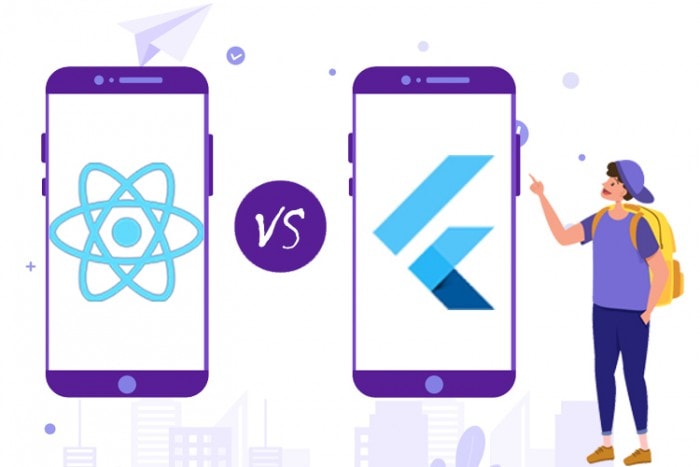
As an ever-increasing number of individuals are grasping modernized innovation, the interest for versatile applications has expanded to an enormous degree. Therefore, For building up a crisp application for new businesses, engineers need something that can make tedious coding time basic and effective.
So as to accomplish this, numerous engineers have begun utilizing the cross-stage application, with the goal that they can use its highlights to structure online business applications, intuitive applications, and social applications. And two of the hottest ones in the IT industry are, React Native and Flutter. But this article will help you in knowing which one is better.
Basic introduction-
Flutter and React native are the two principal advancement structures which are the host of the cross-platform mobile app development. Facebook presented React Native and in a matter of seconds the structure picked up prevalence and the organizations utilizing it were hugely profited.
React Native uses JavaScript as its programming language. On the other hand, Flutter presented by Google is an amateur in the versatile application world. No big surprise Flutter helps designers in making lovely local applications and causes them in creating cross-platform applications effortlessly. Flutter uses a language called Dart.
Let’s analyze both and this correlation will demonstrate to be useful to the new companies as they can without much of a stretch to distinguish which structure will be the best for their versatile application improvement.
- User Interface-
With regards to UI of an application, you will locate a gigantic breach between both. Native depends on local parts and it assumes all the praise for being the most unique structure that improves the client experience. Though Flutter works immaculately with the exclusive gadget sets, that gives vitality.
Winner- React native
-
Performance
How about we begin by saying that the two structures are quick enough to fulfill the necessities of almost all organizations? This being stated, there’s an intriguing distinction with regards to how the two structures gather their code. Flutter vs React native execution mapping is the most ideal approach to distinguish which structure is perfect for versatile mobile application development.
React Native has a bigger network, in any case, engineers know about the agony they face with regards to making hybrid applications. According to the structure, the engineers won’t confront any issue while building up an application in native surroundings.
Engineers some of the time face issues while running React Native application design While Flutter makes it simple for engineers as they can reuse the current code. The C ++ works faultless and underpins the language consequently, Flutter supersedes here. This could be because Flutter uses the Dart code, hence eradicating the JavaScript Bridge which advances its performance
Winner- flutter
-
Development Time
React native has stayed one of the most solid structures for building up a cutting edge application. It is favored by the engineer’s clan in view of its proficiency and it diminished the time allotment for the advancement over that it adds to the UI and takes less time in development.
In the correlation between Flutter versus React Native, Flutter takes additional time being developed. The prepared to utilize segments of React Native makes the advancement procedure straightforward and snappy, subsequently lifts the extent of versatile application improvement without irritating the engineers.
Winner – React Native
-
Stability
When we think about React Native versus Flutter the challenge looks troublesome. The Alpha variant if Flutter left it one stage back as it isn’t suggested for huge undertakings.
Support for React Native and its consistency since the beginning has made it increasingly famous and a solid system. Native, a structure which is as of now settled and acknowledged for its highlights and unwavering quality in the business where Flutter is as yet attempting to make an imprint. Thus React Native is an obvious champ here.
Winner – React Native
-
Customer Base
React Native was, and it is among the most encouraging mobile application development framework. The system can complete the venture of any size. When we talk about the size of the undertaking in this structure a couple of huge names are Facebook, Instagram, Skype, Walmart and so forth.
Flutter on the flip side, which was propelled only a couple of years back, it is as yet attempting to make its essence felt in the business. Since the system is new to the market it will require some investment for it to make a base and be perceived in the market.
Winner – React Native
-
Documentation
Documentation handling is a complex and tedious thing. Be that as it may, Flutter is truly adept at encouraging the documentation; it makes the application designer’s life simple by enabling them to utilize them while archiving their applications. The documentation procedure with React Native isn’t so sorted out. Moreover, the system erases those segments which are helpful to make the procedure smooth. Henceforth here Flutter is the obvious champ.
Winner- Flutter
Thus, I have recorded a nitty-gritty correlation between the two systems that are prominent among new companies for mobile application advancement. Both the structures have their very own in addition to focuses as far as security, execution, documentation and different viewpoints as referenced previously.
Thus, it is hard to figure out which the champ is as both have their own upsides and downsides. Yet, I can say that since Flutter will set aside some more effort to get steady in the business contrasted with React Native. This clarifies React Native is a smart decision, to begin with.
Yet, don’t dispose of Flutter either. Google is intensely putting resources into it and utilizing it inside as well. And the structure has a significant decent piece of publicity driving it forward.
